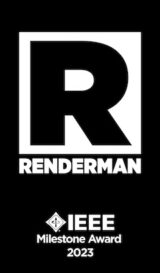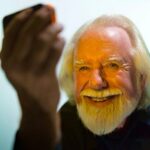Creating RenderMan®: Pixar’s Impact on Computer Graphics is Recognized with an IEEE Milestone
Pat Hanrahan, Tony Apodaca, Darwyn Peachey, Steve May, Jim Lawson

The Pixar website describes this IEEE Milestone dedication event, and PixarMilestone.com is the IEEE website for this Milestone.

This event tells the origin story behind the RenderMan® software that has revolutionized computer graphics since the mid-1980s. It has been used in every Pixar movie, and also for the special effects seen in movies, TV, and on streaming services, as well as for the content recognized with every Visual Effects Oscar® for 17 straight years.
The first session features the early pioneers who created RenderMan® at Pixar, some of whom have personally received Oscar®s for their work – including the first one given for software. It concludes with the unveiling of an IEEE Milestone bronze plaque that recognizes the huge impact of RenderMan® on the world of special effects, and whose impact is now seen worldwide on a daily basis. Officiating for this unveiling are IEEE President-Elect Tom Coughlin and IEEE History Committee member Brian Berg.
The second session presents The Technology of RenderMan®, and includes personal recollections of Pixar and the “coming of age” of this important software.
The title of the Milestone is The Development of RenderMan® for Photorealistic Graphics, 1981-1988, and the citation on its bronze plaque reads:
RenderMan® software revolutionized photorealistic rendering, significantly advancing the creation of 3D computer animation and visual effects. Starting in 1981, key inventions during its development at Lucasfilm and Pixar included shading languages, stochastic antialiasing, and simulation of motion blur, depth of field, and penumbras. RenderMan®’s broad film industry adoption following its 1988 introduction led to numerous Oscar®s for Best Visual Effects, and an Academy Award of Merit Oscar® for its developers.
This event was broadcast live from the Steve Jobs Theater at Pixar Animation Studios in Emeryville, CA. The RenderMan® bronze plaque is mounted by the entrance to Pixar’s campus next to a copy of the Milestone plaque that was dedicated at the University of Utah in March 2023.
 About the speaker, Tom Porter of Pixar Animation Studios
About the speaker, Tom Porter of Pixar Animation StudiosTom Porter joined the Graphics Group at Lucasfilm in 1981. He won three Scientific and Technical Academy Awards for his work there on digital compositing, digital painting, and the solution to motion blur.
Porter served as Shading and Visual Effects Supervisor on Pixar’s first feature film, Toy Story. He was Supervising Technical Director for Monsters, Inc. and continued on as Associate Producer on the Golden Globe®-winning film Cars and Academy Award®-winner WALL•E. From 2009 to 2018, Porter held the role of Senior Vice President of Production at Pixar. He served as as Senior Vice President of Production Strategy until his retirement in 2023 from Pixar.
Ed Catmull co-founded Pixar Animation Studios, and is retired as President of Pixar and Disney Animation Studios. Previously, he was Vice President of the Computer Division of Lucasfilm Ltd., where he managed development in the areas of computer graphics, video editing, video games, and digital audio. Catmull is one of the architects of the RenderMan® rendering software. He has received numerous awards including five Academy Awards; the Gordon E. Sawyer Award; the ACM SIGGRAPH Steven A. Coons Award; and the Progress Medal and the Fuji Gold Medal awards from the Society of Motion Picture and Television Engineers. He and Pat Hanrahan were co-winners of the 2019 ACM Turing Award. His 2014 book Creativity, Inc.: Overcoming the Unseen Forces That Stand in the Way of True Inspiration was a New York Times bestseller.
 About the speaker, Ed Catmull of Pixar Animation Studios (Emeritus)
About the speaker, Ed Catmull of Pixar Animation Studios (Emeritus)
 About the speaker, Alvy Ray Smith of Pixar Animation Studios (Emeritus)
About the speaker, Alvy Ray Smith of Pixar Animation Studios (Emeritus)
Alvy Ray Smith co-founded Pixar Animation Studios with Ed Catmull in 1986, and his invented Spanish verb “Pixar” means “to make pictures.” He has received two technical Academy Awards for his contributions to digital moviemaking technology.
Prior to Pixar, he and Catmull were founding members of the Lucasfilm Computer Graphics Division, established at Industrial Light and Magic in 1979. In 1982, he directed the Genesis Demo in Star Trek II: The Wrath of Khan, the first completely computer-generated cinematic image sequence in a feature film. After Pixar, Alvy became the first Graphics Fellow at Microsoft.
Smith’s recent book A Biography of the Pixel was ten years in the making. It makes numerous concepts easily understandable, from the Universal Turing Machine to the computer animation used in the making of Toy Story, the first fully digital feature film. In the book, Smith posits that just three ideas – waves, computations, and pixels – underlie Digital Light.
 About the speaker, Loren Carpenter of IONS
About the speaker, Loren Carpenter of IONS
Loren Carpenter revolutionized the entire film industry through inventing rendering and modeling algorithms for image synthesis and visual effects. His film career took off when the Lucasfilm Computer Division immediately offered him a job. There he further perfected his software to create the fractal planet for the Genesis sequence of Star Trek II: The Wrath of Khan, a visual effect that worked so well it was used in the next three Star Trek movies. His division at Lucasfilm eventually grew into Pixar Animation Studios, where he became the studio’s first Senior Scientist, and where his revolutionary software algorithms still beat in the heart of every Pixar movie.
In 2001, he and two colleagues were awarded the only Oscar statuettes ever given for computer science. In 2014, he transitioned from his position as Senior Research Scientist in Disney/Pixar’s research division to that of a Scientist at IONS. In 2014, Loren retired from Pixar to join the Institute of Noetic Sciences as a Scientist. At IONS, he has been involved primarily with experiment design and construction, using his extensive fabrication, computer and electronics skills. His contributions include new instruments for recording and analyzing quantum background noise and instruments for sensing and amplifying mind-photon interaction.
 About the speaker, Rob Cook of Pixar Animation Studios (Emeritus)
About the speaker, Rob Cook of Pixar Animation Studios (Emeritus)
Rob Cook was the co-architect and primary author of Pixar’s RenderMan® software. In 2001, he and two colleagues received Oscars for their contributions, the first ever given for software. In 1981, he joined Lucasfilm/Pixar, where he developed the first programmable shader. Programmable shading is an essential part of GPUs and game engines as well as high-end renderers.
He was the first to use Monte Carlo techniques in computer graphics, which was essential for simulation of complex, realistic lights and camera effects. The latter proved particularly important in the special effects industry, because it allowed computer-generated imagery to match the motion blur and depth of field of the live-action footage with which it was combined.
In 1987, he received the ACM SIGGRAPH Computer Graphics Achievement Award in recognition of these contributions, and in 2009, he received the ACM SIGGRAPH Stephen A. Coons Award for his lifetime contributions to the field. In 1999, he was inducted as a Fellow of the Association for Computing Machinery. He has been named to the Academy of Motion Picture Arts and Sciences and to the National Academy of Engineering.
 About the speaker, Pat Hanrahan of Stanford University
About the speaker, Pat Hanrahan of Stanford University
Pat Hanrahan is known for the development of rendering algorithms, used to create realistic images and animations in films, video games, and other applications. He also helped refine the concept of shading languages, which are used to specify the visual appearance of 3D objects. Shading languages now run in real-time on graphics processing units (GPUs) and are widely used in video games, and they subsequently evolved into more general programming environments for GPUs. His work at Stanford on the programming language Brook led to NVIDIA’s CUDA. He and Ed Catmull were co-winners of the 2019 ACM Turing Award.
Hanrahan has also worked extensively on visualization software and algorithms. He co-founded Tableau, software which enables interactive analyzation of large databases.
 About the speaker, Tony Apodaca of Pixar Animation Studios
About the speaker, Tony Apodaca of Pixar Animation Studios
Tony Apodaca is a senior Technical Director at Pixar Animation Studios. He has worn many hats over the course of a more than 37-year career at Pixar, including:
– microprogrammer on custom image processing hardware
– software architect and lead engineer on Pixar’s PhotoRealistic RenderMan® software
– lighting, shading, and rendering TD on many of Pixar’s early short films and feature films, including Tin Toy, Knickknack, Toy Story, Finding Nemo, and Cars
– CG Supervisor on the short films Presto and Partly Cloudy
– CG Supervisor on theme parks experiences involving Pixar characters, includng Remy’s Ratatouille Adventure and Radiator Springs Racers
Tony is a frequent lecturer at SIGGRAPH on RenderMan, and he is co-author of Advanced RenderMan®: Creating CGI for Motion Pictures. He is the recipient of a Scientific and Technical Academy Award for his work on RenderMan®, and of a VES Award for his work on theme park attractions. Tony is also an inventor on a number of patents on topics in image generation and manipulation.
 About the speaker, Darwyn Peachey of Pixar Animation Studios
About the speaker, Darwyn Peachey of Pixar Animation Studios
Darwyn Peachey is the Global Technology Supervisor of a feature film currently in production at Pixar, and also served in this role for Incredibles 2 (2018) and Luca (2021). He joined Pixar as a developer of the RenderMan® rendering system in 1988, and later was a developer of Pixar’s in-house animation system Menv. Darwyn was a recipient of the Academy of Motion Picture Arts & Sciences’ Scientific and Engineering Award in recognition of his work on RenderMan®.
From 1996 to 2003, Peachey was Pixar’s Vice President in charge of software research and development and information technology. His film production roles include technology and visual effects on Toy Story (1995), Ratatouille (2007), Toy Story 3 (2010), and Coco (2017), as well as technical supervision of the stereoscopic 3D versions of Toy Story and Toy Story 2. Darwyn was a sequence lead on Elemental (2023), the Supervising Technical Director of the Oscar-nominated Pixar short film Sanjay’s Super Team (2015), and also for ten Cars and Toy Story short films produced at Pixar Canada. He co-founded and served as the Chief Technical Officer of Pixar Canada, a Pixar subsidiary that operated in Vancouver from 2009 to 2013.
 About the speaker, Steve May of Pixar Animation Studios
About the speaker, Steve May of Pixar Animation Studios
Steve May is Chief Technology Officer at Pixar Animation Studios, where his tenure spans over 25 years. He leads all technology at the studio, including software R&D, information systems, RenderMan, and the development of visual effects tools and processes for each film.
Steve’s initial work at Pixar was as a technical director on Toy Story 2. For their next film, Monsters, Inc., he helped to pioneer the fur technology and overall look for the character Sullivan. He went on to work as a supervising technical director for Finding Nemo, Cars, Up, and Brave.
Prior to Pixar, Steve was a member of the research faculty at The Ohio State University. He received a Ph.D. in Computer Science and Engineering as well as BS and MS degrees from The Ohio State University.
 About the speaker, Jim Lawson of Pixar Animation Studios (Emeritus)
About the speaker, Jim Lawson of Pixar Animation Studios (Emeritus)
Jim Lawson has spent his 48 year professional career writing compilers and system level code for audio/video/graphic applications. He joined the digital audio group in the Computer Division of Lucasfilm Ltd. in 1981.
Following the dismantling of Lucasfilm’s Computer Division, and after a short stint with the DroidWorks, Jim joined Pixar in 1985 as a member of the technical staff working on system level support for two of Pixar’s hardware projects: Adam Levinthal’s FLAP (floating point image processor), and Jeff Mock’s ISM (Transputer array). He worked with Pat Hanrahan, Jeff Mock, and Sam Leffler on porting the REYES software to the Transputer array, with his focus on the shading language subsystem.
After Pixar, Jim joined a San Mateo-based consulting firm, and finished his professional career in a research lab in the EE&CS department at the University of California, Berkeley.




